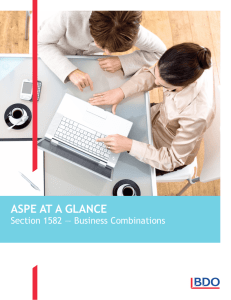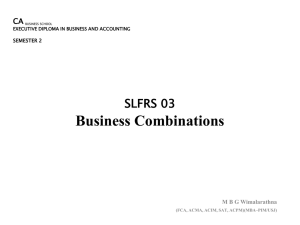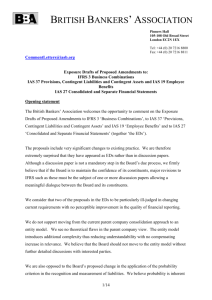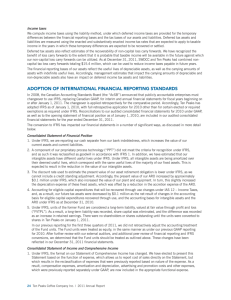IFRS 3 Business Combinations (revised)
advertisement
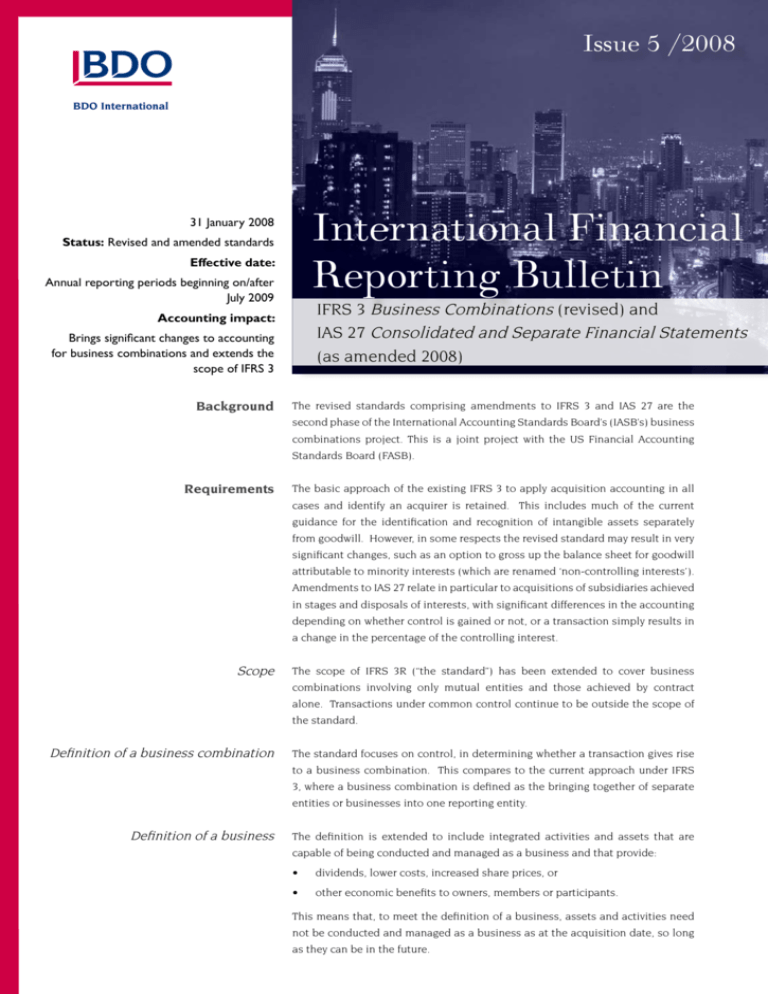
Issue 5 /2008 BDO International International Financial Reporting Bulletin 31 January 2008 Status: Revised and amended standards Effective date: Annual reporting periods beginning on/after July 2009 IFRS 3 Business Combinations (revised) and IAS 27 Consolidated and Separate Financial Statements (as amended 2008) Accounting impact: Brings significant changes to accounting for business combinations and extends the scope of IFRS 3 Background The revised standards comprising amendments to IFRS 3 and IAS 27 are the second phase of the International Accounting Standards Board’s (IASB’s) business combinations project. This is a joint project with the US Financial Accounting Standards Board (FASB). Requirements The basic approach of the existing IFRS 3 to apply acquisition accounting in all cases and identify an acquirer is retained. This includes much of the current guidance for the identification and recognition of intangible assets separately from goodwill. However, in some respects the revised standard may result in very significant changes, such as an option to gross up the balance sheet for goodwill attributable to minority interests (which are renamed ‘non-controlling interests’). Amendments to IAS 27 relate in particular to acquisitions of subsidiaries achieved in stages and disposals of interests, with significant differences in the accounting depending on whether control is gained or not, or a transaction simply results in a change in the percentage of the controlling interest. Scope The scope of IFRS 3R (“the standard”) has been extended to cover business combinations involving only mutual entities and those achieved by contract alone. Transactions under common control continue to be outside the scope of the standard. Definition of a business combination The standard focuses on control, in determining whether a transaction gives rise to a business combination. This compares to the current approach under IFRS 3, where a business combination is defined as the bringing together of separate entities or businesses into one reporting entity. Definition of a business The definition is extended to include integrated activities and assets that are capable of being conducted and managed as a business and that provide: • dividends, lower costs, increased share prices, or • other economic benefits to owners, members or participants. This means that, to meet the definition of a business, assets and activities need not be conducted and managed as a business as at the acquisition date, so long as they can be in the future. International Financial Reporting Bulletin Issue 5, 2008 The acquisition method The acquisition method of accounting remains mandatory for all business combinations within the scope of the standard, and involves four steps: (1) Identifying the acquirer; (2) Determining the acquisition date; (3) Recognising and measuring the identifiable assets acquired, the liabilities assumed, and any non-controlling interest in the acquiree; (4) Recognising and measuring goodwill or a gain from a bargain purchase. Steps 1 and 2 The revised standard retains the approach set out in existing IFRS 3 for the first two of these steps. Changes are proposed for the others. Step 3 Recognising and measuring the identifiable assets acquired, the liabilities assumed, and any non-controlling interest in the acquiree: All identifiable assets acquired and liabilities assumed as a result of the business combination will be measured at their full fair value (even if the business combination involves less than 100% of the acquiree or the business combination is achieved in stages), with fewer exceptions than under the current IFRS 3. The remaining exceptions are deferred tax assets and liabilities, indemnification assets, operating leases, employee benefit plans, reacquired rights, sharebased payment awards and assets held for sale that are within the scope of IFRS 5 Non-current Assets Held for Sale and Discontinued Operations. Operating leases When the acquiree is the lessee the approach for operating leases is that for each (IFRS 3R. Appendix B28 and B42) lease, as at the acquisition date, it is necessary to determine whether it is at a market rate. If an operating lease is not at a market rate, then the acquirer recognises an intangible asset if the terms of the operating lease are more favourable than market rates, and a liability of the terms are less favourable. In cases where the acquiree is the lessor, IFRS 3R Appendix B42 notes that the acquirer does not recognise a separate asset or liability. The terms of an operating lease are taken into account in measuring the acquisition-date fair value of an asset instead. Intangible assets The current IFRS 3 requires intangible assets to be recognised separately from goodwill if they meet the IAS 38 definition and are reliably measurable. The requirement in the existing standard that they be reliably measurable has been dropped, which may result in additional intangible assets being recognised separately. However, an assembled workforce will continue not to be recognised as a separate intangible. Contingent assets and liabilities Similar to the current IFRS 3, the revised standard requires contingent liabilities that are “present” obligations that arose from past events to be measured at fair value at the acquisition date. Contingent assets are still not to be recognised. 2 International Financial Reporting Bulletin Issue 5, 2008 Non-controlling interest in the acquiree The non-controlling interest is the equity in a subsidiary that is not attributable, (IFRS 3R.19 and Appendix B44, Appendix A) can be measured either at its full fair value (including goodwill) or at the non- directly or indirectly, to a parent. The non-controlling interest in the acquiree controlling interest’s proportionate share of the acquiree’s net identifiable assets at the acquisition date. On a per-share basis the full fair value might be different to the fair value per share of the acquirer’s controlling interest in the acquiree because of the inclusion of a discount for lack of control. Step 4 Recognising and measuring goodwill or, less frequently, a gain from a bargain purchase. IFRS 3R.32 notes that: The acquirer shall recognise goodwill as of the acquisition date measured as the excess of (a) over (b) below: (a) the aggregate of: (i) the consideration transferred measured in accordance with this IFRS, which generally requires acquisition-date fair value (see paragraph 37); (ii) the amount of any non-controlling interest in the acquiree measured in accordance with this IFRS; and (iii)in a business combination achieved in stages (see paragraphs 41 and 42), the acquisition-date fair value of the acquirer’s previously held equity interest in the acquiree. (b) the net of the acquisition-date amounts of the identifiable assets acquired and the liabilities assumed measured in accordance with this IFRS. (see also above, Step 3 of acquisition accounting). In a significant change from the current standard, IFRS 3R gives the acquirer the option to either account for the non-controlling interests at fair value or at the non-controlling interest’s proportionate share of the acquiree’s net identifiable assets (IFRS 3R.19). Measuring the non-controlling interests at fair value means that goodwill is recognised and measured at an amount equal to the total fair value exchanged in the purchase transaction less the full fair value of the identifiable assets, and liabilities assumed. While this does not represent a change where 100% of a business is acquired, it is very significantly different where an acquirer owns less than 100%. This is because IFRS 3R permits goodwill attributable to the non-controlling interests to be recognised in the consolidated balance sheet, with the amount attributed to the non-controlling interest in equity being increased accordingly (“full goodwill method”, see step 3 above). 3 International Financial Reporting Bulletin Issue 5, 2008 Consideration transferred by the acquirer IFRS 3R requires all items included in the consideration transferred by the acquirer to be measured at fair value at the acquisition date. In some cases, transferred assets or liabilities remain within the combined entity after the business combination (for example, because the assets or liabilities were transferred to the acquiree rather than to its former owners), and the acquirer therefore retains control of them. In that situation, the acquirer shall measure those assets and liabilities at their carrying amounts immediately before the acquisition date and shall not recognise a gain or loss in profit or loss on assets or liabilities it controls both before and after the business combination (IFRS 3R.38). The fair value of the consideration transferred is calculated as the sum of the acquisition-date fair values of the assets transferred by the acquirer, the liabilities incurred by the acquirer to former owners of the acquiree and the equity interests issued by the acquirer. The exception to this rule is that all or a portion of the acquirer’s share-based payment awards exchanged as replacement for awards held by the acquiree’s employees over equity instruments in the acquired entity may be part of the consideration transferred in the business combination. That portion of the consideration is measured in accordance with IFRS 2 Share based Payment rather than at fair value (see IFRS 3R.37). However, it will be important to consider when determining the appropriate accounting treatment, the guidance in respect of whether the consideration is part of the cost of the acquired business, or remuneration for future employee services (see below). The sum of fair values includes the valuation of contingent consideration arrangements. If contingent consideration is classified (applying IAS 32) as a liability (rather than equity), subsequent changes in fair value will be recognised in accordance with either IAS 39 Financial Instruments: Recognition and Measurement, IAS 37 Provisions, Contingent Liabilities and Contingent Assets, or other IFRSs. Contingent consideration classified as equity is not remeasured. Goodwill is not affected by any subsequent adjustment to contingent consideration. This is a fundamental change from the current standard. Previously held equity interest in the acquiree The amount of any non-controlling interest in the acquired business that the acquirer owned immediately prior to the acquisition of the controlling interest is considered to be part of the consideration transferred. This could be an interest accounted for as an investment, or an interest in an associate or a joint venture. At the point of acquisition of the controlling interest, the existing interest is required to be remeasured at fair value, with any gain or loss being recorded in profit or loss. 4 International Financial Reporting Bulletin Issue 5, 2008 Acquisition-related costs In a further significant change from IFRS 3, the revised standard requires that all transaction costs, such as advisory, legal, accounting and valuation fees, together with all administrative costs, are to be excluded from the consideration transferred or the fair value attributed to the acquired business. Instead, they will be accounted for in accordance with other IFRSs, meaning that they will be charged to the income statement as incurred. A bargain purchase IFRS 3R notes that the price paid for an acquiree (consideration transferred plus amount of non-controlling interest in the acquiree plus fair value of the acquirer’s previously held equity interest in th acquiree) might be less that the net of the acquisition-date fair values of the identifiable assets acquired and the liabilities assumed. This might be the case in a forced sale of a business. In such circumstances, a review is first required of whether the acquiring entity has correctly identified and measured the fair value of: • the identifiable assets acquired and liabilities assumed; • the non-controlling interest in the acquiree; • the acquirer’s previously held non-controlling equity investment in the acquiree (if business combination achieved in stages); and • consideration transferred. If, after this review, the full fair value of the identifiable assets and liabilities assumed stills exceeds the total fair value exchanged in the purchase transaction, the excess will be recognised in profit or loss on the acquisition date. Measurement period The measurement period is the period after the acquisition date during which (IFRS 3R.45 ff) the acquirer may adjust provisional accounting for a business combination. The revised standard carries forward the existing IFRS 3 requirement that if any of the fair value measurements can only be completed provisionally at the acquisition date, any adjustments to those measurements that are to be reflected in the business combination must be completed within 12 months of the acquisition date. If any fair values are provisional, a statement to the effect must be made in the entity’s published financial statements. Like the current IFRS 3, after the end of the 12 month measurement period, the acquirer only revises the accounting for a business combination to correct an error in accordance with IAS 8 Accounting Policies, Changes in Accounting Estimates and Errors. 5 International Financial Reporting Bulletin Issue 5, 2008 Determining what is part of the business combination transaction - assessing whether the exchange consideration is all in respect of the acquired business IFRS 3R clarifies that the consideration payable is not necessarily all exchanged (IFRS 3R.51ff) that this guidance generally articulates more clearly the approach that should for the business acquired. The new standard includes Application Guidance for a number of examples, including where the acquirer and the acquiree have a preexisting relationship or payments are made to compensate employees or former owners of a business for service rendered after the acquisition. It should be noted have been followed under the existing IFRS 3. However, it is possible that the additional clarification in IFRS 3R will result in a change in approach for some entities. In assessing whether consideration represents payment for the business acquired or a different transaction or event (such as post acquisition services), the acquirer is required to consider: • The reasons for the transaction or event; • Who initiated the transaction or event; and • The timing of the transaction or event. Examples of transactions that will not be added to the cost of the acquisition, instead being charged to the income statement, include (but are not limited to): • Transactions that effectively settle pre-existing relationships between the acquirer and the acquiree (such as supply agreements for goods and services); • Transactions that remunerate employees or former owners of the acquiree for future services: and • Transactions that reimburse the acquiree or its former owners for paying the acquirer’s acquisition related costs. Deferred tax arising from a business combination Fair value adjustments to the carrying values in the acquiree of assets acquired, and liabilities assumed, may give rise to temporary differences which will result in the recognition of deferred tax on the acquisition of the business. Fair value adjustments may also change the amount of any deferred tax provision from the amount already recorded by the acquiree. This will affect the amount of goodwill recognised on the business combination. Where a deferred tax asset arises, in a change from current IFRS 3, the revised standard prohibits any subsequent reduction in the carrying value of goodwill arising from changes in the deferred tax asset that are recognised after the date of acquisition. However, there is an exception to this general rule. Where the deferred tax benefits are recognised within the 12 month post acquisition measurement period, there is a rebuttable presumption that any adjustments to the deferred tax balance in that period relate to conditions that applied at the acquisition date. In these circumstances, the goodwill balance is adjusted unless the change to the deferred tax balance is clearly as a consequence of events after the acquisition date (IFRS 3R Appendix C4, IAS 12R.67). 6 International Financial Reporting Bulletin Issue 5, 2008 The revised standard retains the existing IFRS 3 requirement that any adjustments to deferred tax assets of the acquirer that arise as a result of the business combination are excluded from the accounting for the business combination (IFRS 3R Appendix C4, IAS 12R.68). Particular types of business combinations (IFRS 3R.41ff) The revised standard also gives additional guidance for applying the acquisition method to particular types of business combinations including: • Business combinations achieved in stages; • Business combinations achieved without the transfer of consideration. For business combinations achieved in stages (i.e. a transaction where an acquirer gains control over another entity, and previously held an equity interest in that entity) the revised standard requires that the acquirer remeasures its previously held equity interest in the acquiree at its acquisition-date fair value and recognises the resulting gain or loss in profit or loss. This compares with the current IFRS 3 which notes that the date of each exchange transaction is relevant, and requires at each acquisition stage, a step-by-step comparison of the cost of the individual investments with the acquirer’s interest in the fair values of the acquiree’s identifiable assets and liabilities at each step. Further acquisitions of additional non-controlling equity interests after the business combination are accounted for as equity transactions (IAS 27.30 [2008]). This includes adjusting the amount of the remaining non-controlling interest to reflect the change in relative interests in the subsidiary. Any difference between the amount of the adjustment to non-controlling interest and the consideration paid or received by the parent on the change in holding is recognised directly in equity. The same accounting treatment is required for disposals of equity interests while control is retained. In contrast, and consistently with transactions where control is gained, gains or losses from transactions resulting in a loss of control are recognised in profit or loss. The gain or loss includes remeasurement to fair value of any retained equity interest in the investee (IAS 27.30 and 34ff [2008]). Pre-existing relationships A business combination may involve the effective settlement of arrangements that existed prior to the date on which the business combination was contemplated (a ‘pre-existing relationship’). In such cases, a gain or loss is recognised and measured as follows: • for a pre-existing non contractual relationship, such as a law suit: fair value; • for a pre-existing contractual relationship: the lesser of two amounts, which are the amount by which the pre-existing contract is on favourable or unfavourable terms (from the perspective of the acquirer) in comparison with current market rates, and the amount of any settlement provision in the contract available to the counterparty to whom the contract is unfavourable. 7 International Financial Reporting Bulletin Issue 5, 2008 Any gain or loss recognised will be adjusted for any related asset or liability previously recognised by the acquirer (such as a provision for the amount payable in respect of a law suit). Effective settlement of a supply contract as a result of a business combination An illustration of a business combination where there is effective settlement of a pre-existing supply contract between the acquirer and the new subsidiary is set out in paragraph IE54 to IE57. When allocating the cost of the business combination to the fair value of the assets and liabilities of the acquiree, the acquirer has to separate the fair value of the supply contract. The fair value has to be analysed as to whether it contains any favourable or unfavourable component from the acquirers point of view. ‘Favourable’ or ‘unfavourable’ is in the context of whether the contract pricing is below, or above, the price that applies in the marketplace at the acquisition date. Any favourable or unfavourable component has to be recognised in profit or loss immediately. The “at market”-component is part of the goodwill: it does not represent a reacquired right that the acquirer might subsequently reissue to a third party. Disclosures The revised standard requires certain new disclosures, and modifies existing disclosures, which are consistent with the changes in approach to permit recognition of the full fair value of the acquired business, whether or not a 100% interest is acquired. These additional disclosures include: • The primary reasons for the business combination and a description of how the acquirer obtained control of the acquiree. • A qualitative description of the factors that make up the goodwill recognised, such as expected synergies from combining operations of the acquiree and the acquirer, intangible assets that do not qualify for separate recognition, or other factors. • The acquisition-date fair value of the total consideration transferred and the acquisition-date fair value of each major class of consideration such as: • Cash; • Other tangible or intangible assets, including a business or subsidiary of the acquirer; • Liabilities incurred, for example, a liability for contingent consideration; • Equity interests of the acquirer, including the number of instruments or interests issued or issuable and the method of determining the fair value of those instruments or interests. 8 International Financial Reporting Bulletin Issue 5, 2008 • For contingent consideration arrangements and indemnification assets: • The amount recognised at the acquisition date; • A description of the arrangement and the basis for determining the amount of the payment; • An estimate of the range of outcomes (undiscounted) or, if a range cannot be estimated, that fact and the reasons why a range cannot be estimated. If the maximum amount of the payment is unlimited, the acquirer is required to disclose that fact. • For each contingent liability recognised in accordance with IFRS 3R.23, the information required in IAS 37.85, which includes: (a) a brief description of the nature of the obligation and the expected timing of any resulting outflows of economic benefits; (b) an indication of the uncertainties about the amount or timing of those outflows. Where necessary to provide adequate information, an entity shall disclose the major assumptions made concerning future events, as addressed in paragraph 48 [of IAS 37]. If a contingent liability is not recognised because its fair value cannot be measured reliably, the acquirer shall disclose: • The information required by IAS 37.86: “Unless the possibility of any outflow in settlement is remote, an entity shall disclose for each class of contingent liability at the balance sheet date a brief description of the nature of the contingent liability and, where practicable: (a) an estimate of its financial effect, measured under paragraphs 36-52 [of IAS 37}; (b) an indication of the uncertainties relating to the amount or timing of any outflow; and (c) the possibility of any reimbursement.”; and • The reasons the liability cannot be measured reliably. • The total amount of goodwill that is expected to be deductible for tax purposes. 9 International Financial Reporting Bulletin Issue 5, 2008 • For transactions that do not form part of the business combination and are therefore recognised separately from the acquisition of assets and assumptions of liabilities in the business combination in accordance with IFRS 3R.51 (e.g. where the acquirer and the acquiree have a pre-existing relationship): • A description of each transaction; • How the acquirer accounted for each transaction; • The amounts recognised for each transaction and the line item in the financial statements in which each amount is recognised; • If the transaction is the effective settlement of a pre-existing relationship, the method used to determine the settlement amount. • The disclosure of separately recognised transactions required by IFRS 3R. Appendix B64(l) and (m) includes the amount of acquisition-related costs, the amount recognised as an expense and the line item or items in the income statement in which those expenses are recognised. The amount of any issue costs (such as for example, costs in respect of the issue of new equity instruments) not recognised as an expense and how they were recognised also shall be disclosed. • In a bargain purchase: • The amount of any gain recognised in accordance with IFRS 3R.34 and the line item in the income statement in which the gain is recognised; • A description of the reasons why the transaction resulted in a gain. • For each business combination in which the acquirer holds less than 100 percent of the equity interests in the acquiree at the acquisition date: • The amount of the non-controlling interest in the acquiree recognised at the acquisition date and the measurement basis for that amount; • For each non-controlling interest in an acquiree measured at fair value, the valuation techniques and key model inputs used for determining that value. • In a business combination achieved in stages: • The acquisition-date fair value of the equity interest in the acquiree held by the acquirer immediately before the acquisition date; • The amount of any gain or loss recognised as a result of remeasuring to fair value the equity interest in the acquiree held by the acquirer before the business combination (see IFRS 3R.42) and the line item in the income statement in which that gain or loss is recognised. 10 International Financial Reporting Bulletin Issue 5, 2008 • For all business combinations: • The amounts of revenue and profit or loss of the acquiree since the acquisition date included in the consolidated income statement for the reporting period; • The revenue and profit or loss of the combined entity for the current reporting period as though the acquisition date for all business combinations that occurred during the year had been as of the beginning of the annual reporting period. Profit and loss attributed to noncontrolling interests IAS 27.28 [2008] notes that total comprehensive income is attributed to the owners of the parent and to the non-controlling interests even if this results in the non-controlling interests having a deficit balance. This could apply where a non wholly owned subsidiary was loss making. Effective date and transition The revised IFRS 3 and IAS 27 will apply to business combinations taking place during accounting periods commencing on or after 1 July 2009. Earlier application is permitted, although this is limited to accounting periods commencing on or after 30 June 2007. If the revised IFRS 3 were to be applied early, this would need to be disclosed and the revised version of IAS 27 would also need to be applied. Assets and liabilities that arose from business combinations whose acquisition dates preceded the application of this IFRS are not adjusted on the adoption of IFRS 3R (i.e. the new standard is applied prospectively). An entity, such as a mutual entity, that has not yet applied IFRS 3 and that had one or more business combinations that were accounted for using the purchase method is required to apply the transition provisions in Appendix B68 and B69. In summary these two paragraphs note the following: IFRS 3R.64 provides that this IFRS applies prospectively to business combinations for which the acquisition date is on or after the beginning of the first annual period beginning on or after 1 July 2009. For business combinations involving only mutual entities or by contract alone and given the acquisition date for that business combination is before the application of this IFRS, IFRS 3R Appendix B69 notes that this prospective application implies that: (1) An entity shall continue to classify the prior business combination in accordance with the entity’s previous accounting policies for such combinations. (2) The carrying amount of previously recognised goodwill in accordance with the entity’s previous accounting policies is only amended by way of eliminating any amortisation previously recognised. 11 International Financial Reporting Bulletin Issue 5, 2008 (3) Goodwill previously recognised as a deduction from equity is neither recognised as an asset nor does the entity recognise in profit or loss any part of that goodwill when it disposes of all or part of the business to which that goodwill relates or when a cash-generating unit to which the goodwill relates becomes impaired. (4) When accounting subsequently for goodwill, no amortisation is recognised. The goodwill is tested in accordance with IAS 36 for any impairment. (5) Previously recognised negative goodwill is eliminated at the beginning of the first annual period in which this IFRS is applied with a corresponding adjustment to the opening balance of retained earnings at that date. Income taxes For business combinations in which the acquisition date was before the effective date of this IFRS is applied, the acquirer applies the requirements of IAS 12.68, as amended by this IFRS prospectively. Therefore: a. The acquirer does not adjust the accounting for prior business combinations for previously recognised changes in recognised deferred tax assets. b. The acquirer recognises, as an adjustment to income tax expense (or a direct adjustment to equity in accordance with IAS 12.61), changes in recognised deferred tax assets. Action required The requirements of the revised standards are complex and, in certain respects, will bring accounting that is significantly different from that required by the current version of IFRS 3 and IAS 27. Entities which report in accordance with IFRS, or anticipate adopting IFRS in the future, should review the new requirements carefully. It may be appropriate to revisit planned transaction structures, and early communication of the effect of the new requirements to investors may be appropriate. BDO International BDO International is a world wide network of public accounting firms, called BDO Member Firms, serving international clients. Each BDO Member Firm is an independent legal entity in its own country. The network is coordinated by BDO Global Coordination B.V. incorporated in the Netherlands, with an office in Brussels, Belgium, where the Global Coordination Office is located. The information in this bulletin is for general guidance only and is not a substitute for professional advice. The BDO Member Firms accept no responsibility for any actions taken or not taken on the basis of the information in this bulletin. © BDO Global Coordination B.V. 2008. http://www.bdointernational.com 12
